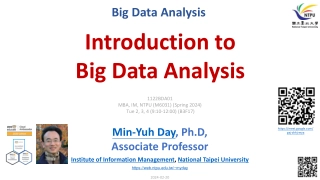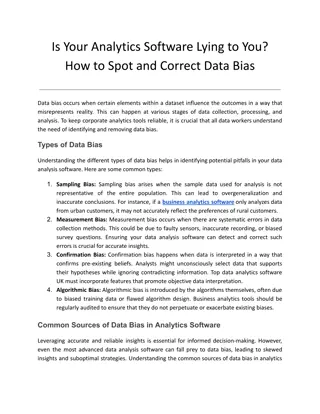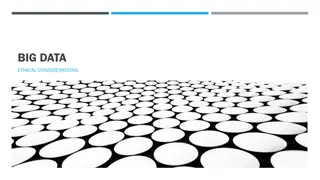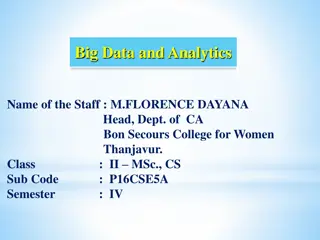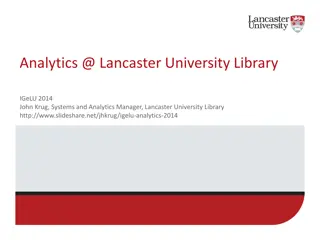Big Data Analytics with Parallel Jobs at University of California at Berkeley
Delve into the world of big data analytics with parallel jobs at the University of California at Berkeley. Explore the rising philosophy of data-ism, massive parallelization, computation frameworks, efficient job execution, and challenges in scaling data size and parallelism. Discover the impact of IO-intensive tasks and proposals to move all data to memory for faster processing. Can the inputs fit in cache? Explore real-world scenarios from Dryad and Hadoop clusters, and learn about the promise and complexities of big data analytics.
Download Presentation

Please find below an Image/Link to download the presentation.
The content on the website is provided AS IS for your information and personal use only. It may not be sold, licensed, or shared on other websites without obtaining consent from the author.If you encounter any issues during the download, it is possible that the publisher has removed the file from their server.
You are allowed to download the files provided on this website for personal or commercial use, subject to the condition that they are used lawfully. All files are the property of their respective owners.
The content on the website is provided AS IS for your information and personal use only. It may not be sold, licensed, or shared on other websites without obtaining consent from the author.
E N D
Presentation Transcript
Big Data Analytics with Parallel Jobs Ganesh Ananthanarayanan University of California at Berkeley http://www.cs.berkeley.edu/~ganesha/
Rising philosophy of data-ism Diagnostics and decisions backed by extensive data analytics "In God we trust. Everybody else bring data to the table. Competitive and Social Benefits Dichotomy: Ever-increasing data size and ever-decreasing latency target
Parallelization Massive parallelization on large clusters Data growing faster than Moore s law Computation Frameworks Dryad
Computation Frameworks Job DAG of tasks Outputs of upstream tasks are passed downstream Job s input (file) is divided among tasks Every task reads a block of data Computation and storage are co-located Tasks scheduled for locality
Computation Frameworks Task1 Task3 Task2 Block Slot
Promise of Big Data Analytics Goal:Efficient execution of jobs Completion time and utilization Challenge: Scale Data size and parallelism Performance variations stragglers Efficient and fault-tolerant execution of parallel jobs on large clusters
IO intensive Memory Tasks are IO intensive Task completes faster if its input is read off memory instead of disk Memory local task Falling memory prices 64GB/machine at FB in Aug 2011, 256GB/machine not uncommon now
Can we move all data to memory? Proposals for making RAM as the new disk (e.g., RAMCloud) Huge discrepancy between storage and memory capacities 200x more data on disks than available memory Use memory as cache
Will the inputs fit in cache? Production traces Dryad and Hadoop clusters Thousands of machines Over 1 million jobs in all, span of 6 months (2011-12)
Will the inputs fit in cache? Heavy-tailed distribution of jobs sizes 92% of jobs can fit their inputs in memory
We built a memory cache Simple in-memory distributed cache Cache input data of jobs Schedule tasks for memory locality Simple cache replacement policies Least Recently Used (LRU) and Least Frequently Used (LFU)
We built a memory cache Replayed the Facebook trace of Hadoop jobs Jobs sped up by 10% with LFU; hit-ratio of 67% Belady s MIN (optimal) 13% improvement with hit-ratio of 74% How do we make caching really speedup parallel jobs?
Parallel jobs require a new class of cache replacement algorithms
Parallel Jobs Tasks of small jobs run simultaneously in a wave Task duration (uncached input) Task duration (cached input) slot1 slot1 slot1 slot2 slot2 slot2 time time time completion time All-or-Nothing: Unless all inputs are cached, there is no benefit completion time completion time
All-or-Nothing for multi-waved jobs Large jobs run tasks in multiple waves Number of tasks is larger than number of slots Wave-width: Number of parallel tasks of a job slot1 slot2 slot3 slot4 slot5 time completion time
All-or-Nothing for multi-waved jobs Large jobs run tasks in multiple waves Number of tasks is larger than number of slots Wave-width: Number of parallel tasks of a job slot1 slot2 slot3 slot4 slot5 time completion time
All-or-Nothing for multi-waved jobs Large jobs run tasks in multiple waves Number of tasks is larger than number of slots Wave-width: Number of parallel tasks of a job slot1 slot2 slot3 slot4 slot5 time completion time
All-or-Nothing for multi-waved jobs Large jobs run tasks in multiple waves Number of tasks is larger than number of slots Wave-width: Number of parallel tasks of a job slot1 Cache at the wave- width granularity slot2 slot3 slot4 slot5 time completion time
Cache at the wave-width granularity Job with 50 tasks, wave-width of 10 All-or-nothing
How to evict from cache? View at the granularity of a job s input (file) Evict from incompletely cached waves Sticky Policy Task duration (uncached input) Task duration (cached input) slot1 slot2 slot3 slot4 slot5 slot6 slot7 slot8 slot1 slot2 slot3 slot4 slot5 slot6 slot7 slot8 completion Job 1 Job 1 With Sticky Policy Without Sticky Policy Job 2 Job 2 a completion Hit-ratio: 50% No speed-up of jobs Hit-ratio: 50% Job 1 speeds up
Which file should be evicted? Depends on metric to optimize: User centric metric Completion time of jobs Operator centric metric Utilization of the cluster What are the eviction policies for these metrics?
Reduction in Completion Time D Idealized model for job: Wave-width for job: W Frequency predicts future access: F Task duration is proportional to data read: D Speedup factor for cached tasks: W Cost of caching: Benefit of caching: Benefit/cost: time WD D F F/W Completion Time of Job: frequency/wave-width
How to estimate W for a job? Wave-width (slots) Job size Use the size of a file as a proxy for wave-width Relative ordering remains unchanged
Improvement in Utilization D Idealized model for job: Wave-width for job: W Frequency predicts future access: F Task duration is proportional to data read: D Speedup factor for cached tasks: W Cost of caching: Benefit of caching: Benefit/cost: WD D F F time W Utilization of job: frequency
Isnt this just Least Frequently Used? All-or-Nothing property matters for utilization Inter-dependent tasks overlap Reduce tasks start before all map tasks finish (to overlap communication) All-or- Nothing No wastage!
Cache Eviction Policies Completion time: LIFE (Largest Incomplete File to Evict) Evict from file with lowest (frequency/wave-width) Sticky: fully evict a file before next (all-or-nothing) Utilization policy: LFU-F (Least Frequently Used File granularity) Evict from file with the lowest frequency Sticky: fully evict a file before next (all-or-nothing)
How do we achieve the sticky policy? Caches are distributed Blocks of files are stored across machines How do we know which files are incomplete? Coordination Global view of all the caches which blocks to evict (sticky policy) where to schedule tasks (memory locality)
PA Man: Centralized Coordination Global view DFS: Distributed File System
Evaluation Setup Workload derived from Facebook & Bing traces Prototype in conjunction with HDFS Experiments on 100-node EC2 cluster Cache of 20GB per machine
Reduction in Completion Time Replacement Policy MIN LRU LFU LIFE Reduction in average completion time (%) 13% 9% 10% 53% Hit-Ratio (%) 59% 33% 48% 45% Sticky Policy
Improvement in Utilization Replacement Policy LRU LFU MIN LFU-F Improvement in utilization (%) 13% 46% 51% 54% Sticky Policy
PAMan: Scalability PACMan Coordinator Near-uniform latency of 1.2ms with up to 11,000 clients/s PACMan Client Can scale up to 20 simultaneous tasks on the machine Coordination infrastructure is sufficiently scalable
How far is LIFE from the optimal for speeding up parallel jobs?
Caches for parallel jobs are complex! Maximize # of job hits (a la Belady s MIN) Job hit = 1 if all inputs are cached; = 0 otherwise 1. Cache space: Aggregated vs. Distributed vs.
Caches for parallel jobs are complex! Maximize # of job hits (a la Belady s MIN) Job hit = 1 if all inputs are cached; = 0 otherwise 1. Cache space: Aggregated vs. Distributed 2. Partial overlap of input blocks between jobs Job 1 Job 2
Caches for parallel jobs are complex! Maximize # of job hits (a la Belady s MIN) Job hit = 1 if all inputs are cached; = 0 otherwise 1. Cache space: Aggregated vs. Distributed 2. Partial overlap of input blocks between jobs 3. Inputs: Equal-sized vs. varying wave-width Blocks Jobs
Simplifying Assumptions 1. Cache space: Aggregated vs. Distributed At ~100% locality, aggregated ~ distributed Assume: Aggregated cache space 2. Partial overlap of input blocks between jobs 98% of jobs have no partial overlap Assume: No partial overlap 3. Inputs: Equal-sized vs. varying wave-width
Notation Jobs indexed by 1, 2, , n Job ihas wave-width wi and frequency fi Total cache space = C Single-waved jobs
Problem Definition Job ihas wave-width wi and frequency fi Total cache space = C xi : if input of job i is in cache Maximize # job hits Maximize ifixi Subject to iwixi C xi = 0, 1 Solution to 0-1 knapsack is optimal cache configuration
Theorem: Favoring (Frequency/wave-width) is (1-1/K) optimal, where K = C/(maxiwi). Comparing job hits ( ifixi) Linear Relaxation Truncation Discard fractional item from linear relaxation 0-1 Knapsack 0 xi 1 xi = 0, 1 * (frequency/wave-width) is optimal solution *Discarded input is one with largest wave-width
LIFE + Optional Eviction Theorem: LIFE + Optional Eviction is (1-1/K) optimal, where K = C/(maxiwi). Optional eviction = can evict input of incoming job (unlike traditional caches)
LIFE + Optional Eviction Replacement Policy Reduction in average completion time (%) 53% 61% 63% LIFE LIFE + Optional Eviction Optimal Most jobs are small (heavy-tailed distribution) K and (1-1/K) 1; LIFE + Optional Eviction Optimal Optional Eviction: Practical improvement to LIFE
PAMan Highlights All-or-nothing property for parallel jobs Cache at granularity of wave-widths PACMan: Coordinated in-memory caching system Cache replacement policies for completion time (LIFE) and utilization (LFU-F); not hit-ratio Optimality analysis; close approximation
Straggler Mitigation Stragglers: slow tasks that delay job completion All-or-Nothing job as slow as the slowest task Mantri (for large production jobs) First work to present insights from the wild Cause-aware solution; in deployment at Bing Dolly (for small interactive jobs) Clone jobs upfront; pick first to finish Heavy-tailed job sizes mitigate nearly all stragglers with just3% extra resources
Promise of Big Data Analytics Efficient and fault-tolerant execution of parallel jobs PACMan: Coordinated Memory Caching for Parallel Jobs , NSDI 12 Scarlett: Coping with Skewed Popularity Content in MapReduce Clusters , EuroSys 11 True Elasticity in Multi-Tenant Data-Intensive Compute Clusters , SoCC 12 Disk-Locality in Datacenter Computing Considered Irrelevant , HotOS 11 & Locality Caching Mitigation Straggler Reining in Outliers in MapReduce Clusters using Mantri , OSDI 10 Effective Straggler Mitigation: Attack of the Clones , NSDI 13 Why let resources idle? Aggressive Cloning of Jobs with Dolly , HotCloud 12
onclusion All-or-Nothing property of parallel jobs PA Man: Coordinated Cache Management Provably optimal cache replacement Straggler mitigation Cause-based solution for large jobs, cloning for small jobs




